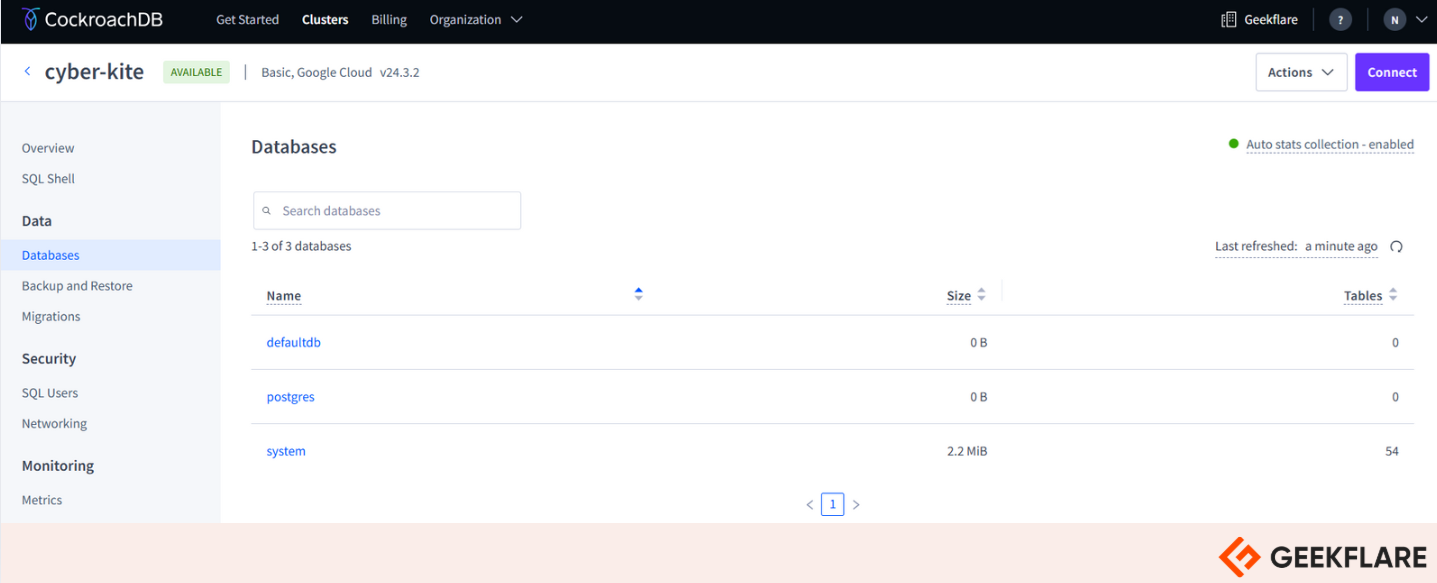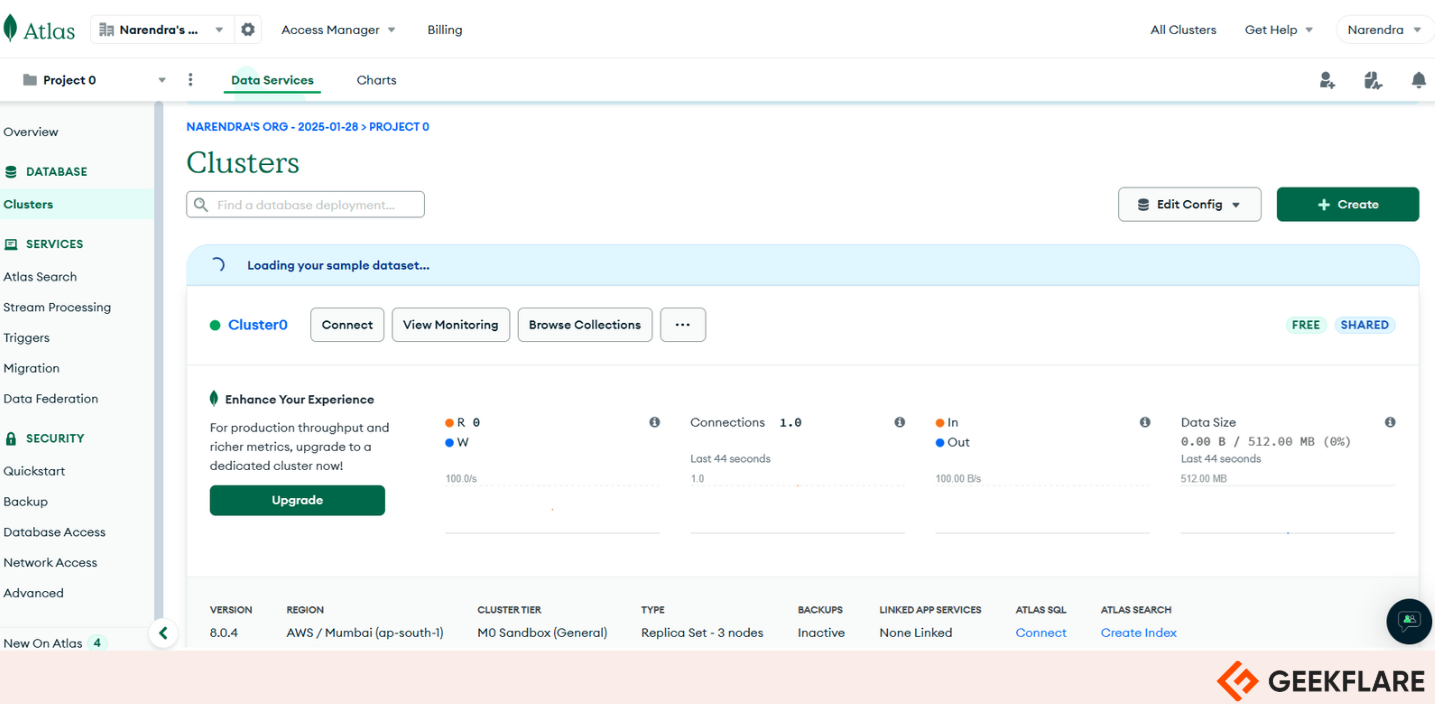We earn commission when you buy through affiliate links.
This does not influence our reviews or recommendations.Learn more.
With so many options available, choosing the right open-source database can be challenging.

you’re able to trust Geekflare
At Geekflare, trust and transparency are paramount.
MySQL
MySQL is a widely used open-source database system developed by Oracle.
Its a go-to choice for building web apps, managing data, and handling fast and reliable database needs.

It uses SQL to store and manage data effectively.
It works well for most use cases, so theres no mystery to its success.
Initially designed for online transaction processing (OLTP), MySQL is still great for handling transactional data.

Today, Oracles MySQL HeatWave cloud service has expanded its capabilities to include analytics and machine learning.
Its still the backbone of many websites today.
Its perfect for websites, e-commerce platforms, or blogs.
MySQL handles extensive data and works well with popular programming languages like PHP, Python, and JavaScript.
Its not ideal for very large-scale, highly distributed systems.
It works on Linux, macOS, Windows, and BSD systems.
It handles complex data, geospatial tasks, or high transaction workloads.
PostgreSQL is secure and protects your data with features like role-based access control and encryption.
This makes it a reliable choice for finance, healthcare, web development, and data analytics industries.
A global community of developers actively improves PostgreSQL.
The latest version, PostgreSQL 17.2, was released on November 21, 2024.
PostgreSQL is not a good choice if your data isnt relational or has unique system requirements.
While PostgreSQL does support document storage, it doesnt perform well with very large datasets.
Check out thisSQL & PostgreSQL for Beginners courseif you are interested in learning more.
This software is trusted by big brands like Wikipedia, WordPress.com, and Google.
It is a fast, scalable, and reliable solution for transforming data into structured information.
Perfect for banking systems, websites, and beyond, MariaDB efficiently handles diverse applications.
MariaDB offers a variety of storage engines tailored to specific needs.
The Spider storage engine facilitates distributed transactions by enabling the creation of distributed databases.
The ColumnStore engine provides a columnar storage solution suitable for analytical workloads.
Aria enhances performance for complex queries, particularly in read-heavy workloads.
Check out how toinstall and configure MariaDB
4.
CockroachDB
CockroachDB is a distributed SQL database designed for high availability, scalability, and strong consistency.
Itssource codeis freely available.
CockroachDB is cloud-native and can be deployed across various cloud providers or on-premises infrastructures.
It is built to automatically replicate, rebalance, and recover with minimal configuration and operational overhead.
Its perfect for apps that require high availability and fast performance, even during failures.
CockroachDB is an innovative solution, but it may not be ideal for every use case.
You may encounter limitations and edge cases if your system relies heavily on advanced or non-standard SQL features.
Its unsuitable for scenarios requiring extremely low-latency, single-node performance, as its distributed architecture can introduce overhead.
ClickHouse
ClickHouse is a fast, open-source database designed for analyzing large amounts of data (OLAP).
With multi-master asynchronous replication, ClickHouse can run across multiple data centers, ensuring no single point of failure.
If a node or even a whole data center goes down, reads and writes remain unaffected.
ClickHouse organizes your data efficiently, making analyzing and building reports easy.
It uses standard SQL, so you dont need to learn new APIs.
Its columnar storage keeps more data in memory, enabling quicker responses than row-based systems with similar hardware.
Its cost-effective, too.
ClickHouse works well with affordable hardware, including traditional disk drives, without sacrificing speed.
It minimizes CPU and disk usage, optimizing every part of your infrastructure.
The system scales easily, running on a single server or thousands of nodes in a cluster.
ClickHouse Key Features
6.
MongoDB
MongoDB Community Edition is a free, open-source database that you’re free to manage yourself.
Instead of using tables like traditional databases, MongoDB stores data as documents, similar to JSON files.
All related data, like a users contact details and access levels, are grouped in one place.
When you retrieve a users data, everything connected to it comes alongno need for complex joins.
MongoDB is versatile and can handle many types of applications.
With the Community Edition, you might host it on your rig or in the cloud.
The Community Edition includes essential security features like encryption, authentication, role-based access, and secure connections.
However, setting up and managing these security controls takes time and effort.
Its great for quickly building prototypes because it doesnt require a strict schema.
When scaling is needed, MongoDB shines without the high costs of cloud SQL services.
MongoDBs flexible schema can cause problems if not managed well.
Issues like mismatched data, missing values, or unnecessary fields can quickly occur.
RethinkDB
RethinkDB is an open-source JSON database explicitly designed for real-time web apps.
This unique feature makes building scalable real-time applications much easier and faster.
Its client drivers work on any platform supported by their programming language.
Both the server and client libraries are available under the Apache License v2.0.
RethinkDB Key Features
RethinkDB is a good option if your app needs real-time updates to data.
Many modern apps need to push data to users instantly, and RethinkDB is designed for that.
Tools like Hadoop or column-based databases like Vertica are more suitable for deep computational analytics.
SQLite
SQLite is a lightweight, self-contained SQL database that doesnt need a server or any setup.
SQLite stores the entire database (tables, indexes, triggers, views) in a single file.
It works directly with disk files, skipping the need for a server.
Its often considered a replacement for basic file operations likefopen().
It works well for small to medium CMSs and demo apps.
SQLite is great but lacks some features in SQL databases, like clustering, stored procedures, and scripting.
It also doesnt have a client for connecting, querying, or exploring the database.
As your app grows, SQLites performance can slow down.
It works in the cloud, on-premises, or across both.
When you gotta scale up by adding nodes or data centers, Cassandra moves data between nodes quickly.
Apache Cassandra Key Features
Cassandra is perfect for handling massive data, like logs and analytics.
Its designed for high availability and can manage huge workloads without downtime.
Big names like Apple and Netflix use it for its scalability and reliability.
Cassandra isnt the best choice if you need complex aggregations or advanced query features.
It sacrifices data consistency for high availability, so its unsuitable for systems requiring precise, real-time read accuracy.
Apache CouchDB
Apache CouchDB is a free, open-source NoSQL database created by the Apache Software Foundation.
It is simple to use, scalable, and excellent at handling data replication.
It stores data in JSON format using a document-based model.
It is a great choice for a single-node database, working well with any system server.
Most users start with a single-node setup and can later upgrade to a cluster for more demanding needs.
CouchDB can also run as a cluster, combining multiple servers or virtual machines into a single database server.
This setup increases capacity and ensures high availability without requiring changes to APIs.
Apache CouchDB makes it easy to access your data wherever you need it.
it’s possible for you to store your data securely on your own servers or with major cloud providers.
CouchDB is a great choice for web and native apps because it uses JSON and supports storing binary files.
With the Couch Replication Protocol, your data moves smoothly between servers, mobile devices, and browsers.
This supports offline functionality while staying reliable and fast.
CouchDB also offers an easy-to-use query language and optional MapReduce for powerful and efficient data access.
In such cases, data created on the users gear is stored locally.
It takes up much more storage than other databases because it keeps extra copies of data and tracks conflicts.
This also makes its write speeds very slow.
CouchDB isnt ideal for managing schemas, as it doesnt handle schema changes well.
Check out45+ Best Database SoftwareYou Should Know
11.
FerretDB
FerretDB is an open-source document database that works like MongoDB but stores data in PostgreSQL or other databases.
It lets you use MongoDB commands while keeping your data in PostgreSQL.
FerretDB is a document database that uses commands, drivers, and tools similar to MongoDB for storing data.
Its a low-cost option for creating scalable, enterprise-grade databases.
It stores data as structured objects with rows and columns, perfect for massive, complex searches and transactions.
FerretDB is fast, efficient, and highly customizable, fitting the needs of both beginners and experienced users.
Its a cost-effective way to handle large and complex data with ease.
FerretDB Key Features
12.
TimescaleDB
TimescaleDB is a free, open-source database built on PostgreSQL, designed to handle time-series data efficiently.
Its great for storing and analyzing data from IoT devices, financial systems, DevOps monitoring, and more.
Its perfect for managing trends and insights over time.
Avoid TimescaleDB for non-time-series data, small datasets, or use cases requiring advanced NoSQL features.